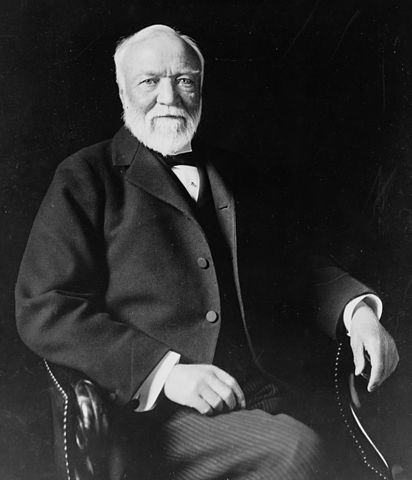*Image Credit: Wikimedia Commons After decades of enormous success and generous donations, legendary captain of industry Andrew Carnegie died on August 11, 1919 – likely as the second wealthiest man in history behind John D. Rockefeller. Having emigrated to the United States with his parents at the age of 13, Carnegie ascended from a position in a cotton mill to be the head of one of the most impressive and profitable companies that has ever existed. Born in Dunfermline, Scotland on November 25, 1835, the young Carnegie spent his early years living in the modest home of a weaver – his father William’s profession. As demand for the specific damask William produced waned and the country slipped into famine, he elected to take out a loan and move the family to Allegheny in western Pennsylvania during 1848. Andrew, early in his teens at this point, took a job replacing spools of thread in a nearby cotton mill, contributing $1.20 a week to his family’s expenses. Two years later, Carnegie obtained a position with the Ohio Telegraph Company for a significant raise, taking full advantage of the opportunity to meet and get to know most of Pittsburgh’s leading businessmen, even gaining a modicum of fame for his ability to recognize a face and decipher a telegraph message simply by listening to the tones. Believing education a key to elevation, he continued to read and pursue his interest in theater in his free time, borrowing books from mentor Colonel James Anderson. The Pennsylvania Railroad Company hired Carnegie in 1853, giving him the job that would lead to his rapid climb into the titans of business. Taken under the wing of Thomas A. Scott, he soon advanced from the role of telegraph operator and secretary to being superintendent of the Pittsburgh Division. Noticing the vast expansion of trains as a means of transportation for people and goods, Carnegie soon began investing in a variety of related industries, accumulating wealth and, during the Civil War, aiding the Union in keeping rail lines and telegraph wires open despite Confederate sabotage. A series of successful investments near the end of the Civil War – particularly in oil – allowed Carnegie to open a manufacturing business focused on building ironworks to support the railroads with which he was so familiar. The Keystone Bridge Company, with two steel mills in Pittsburgh, became a chief supplier for his former employer, Pennsylvania Railroad, but the big change happened after Carnegie visited England to witness a new method of producing high-quality steel rapidly. When he returned to the United States and modified the Bessemer method slightly, he was able to make a fortune – one that allowed him to buy up rival steel producers and create a monopoly before trade regulations prohibited it. In 1901, now one of the wealthiest men in the world thanks to his success, Carnegie decided retirement suited him well and sold his company to JP Morgan for $480 million – at least $13 billion in today’s money. Satisfied with his career as a businessman, Carnegie spent the rest of his life allocating his fortune in the public interest. Though Carnegie Hall in New York and Carnegie Mellon University in Pittsburgh are the most famous of his beneficiaries, funding libraries to encourage others to read as he had would be where he had the widest impact. At the time of his death on August 11, 1919, more than half of the libraries in the United States – nearly 1,700 – bore his name, part of a worldwide legacy of more than 2,400.
August 11, 1919 CE – Scottish Industrialist and Philanthropist Andrew Carnegie Dies
*Image Credit: Wikimedia Commons After decades of enormous success and generous donations, legendary captain of industry Andrew Carnegie died on August 11, 1919 – likely as the second wealthiest man…
